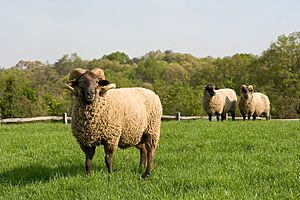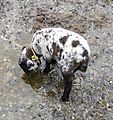Hog Island sheep facts for kids

Hog Island sheep kept at George Washington's Mount Vernon estate
|
|
| Conservation status | Critical |
|---|---|
| Country of origin | United States |
| Traits | |
| Weight |
|
| Wool color | most individuals white (about 10% are black) |
| Face color | white with black speckles |
|
|
The Hog Island sheep is a special type of sheep. It comes from animals first brought to Hog Island in Virginia a long time ago. In the 1930s and 1940s, big storms made people leave the island. Some sheep were left behind.
These sheep learned to live on their own without human help. They became what we call feral animals. Today, different groups work to protect this breed. They are important because they connect us to American history. They also look like sheep from the past. Plus, they have special traits that many modern sheep breeds don't have anymore.
Contents
What Makes Hog Island Sheep Special?
Hog Island sheep are known for being tough and strong. They are a feral breed, meaning they lived in the wild for many years. These sheep are thought to be related to Merino sheep and other English breeds.
They are not very big. Male sheep, called rams, usually weigh about 125 pounds (57 kg). Female sheep, called ewes, weigh around 90 pounds (41 kg). When lambs are born, their wool can be spotted or speckled. Most adult sheep (about 90%) have white wool. About 10% of them have black wool. Both male and female Hog Island sheep can have horns. About half of all these sheep have horns.
These sheep are not often used on big farms today. This is because they are very rare. Also, modern sheep breeds are raised for different things. For example, they might be bred to grow very large or produce a lot of wool. But Hog Island sheep are still important to save. They can teach us about American history. They also have useful traits like being tough and good at finding their own food. They are also good at using food efficiently and have easy lambing.
A Look Back: History of Hog Island Sheep
Hog Island was settled in the 1600s. The first sheep brought by settlers were likely English breeds. But Merino sheep were also known to live on barrier islands. These Merinos might have come from Spanish ships that crashed. The early settlers probably had a mix of these sheep in their flocks.
Since Hog Island was an island, it had lots of open space. There were also no big predators. So, the settlers let their sheep roam freely. They only gathered them to mark them or to use them for meat and wool.
In 1933, a powerful hurricane hit the island. It destroyed most of the settled areas. Many people left the island. Because of this, many sheep were left behind. They had to take care of themselves and became wild again.
In the 1970s, a group called The Nature Conservancy bought the island. They gathered the sheep and moved them. This was done to stop the sheep from overgrazing the island. Today, Hog Island sheep are very rare. There are fewer than 200 registered animals. Because of this, The Livestock Conservancy lists them as "critical."
Protecting the Breed: Research and Conservation
When The Nature Conservancy bought Hog Island, many of the sheep went to private owners. Some were taken to Virginia Tech in Blacksburg. Researchers there studied the sheep. They wanted to know why the sheep seemed to have fewer parasites. They found that the sheep were just isolated from parasites.
After this, the sheep were sent to important places. These included George Washington's birthplace and Mount Vernon. They also went to Colonial Williamsburg and the National Colonial Farm at Piscataway Park. These places help protect endangered farm animals. They also teach the public about them.
The United States Department of Agriculture also helps. Their National Animal Germplasm Program has collected samples from these sheep. This program saves genetic material from animals important to American history. Hog Island sheep look like the small, short-wooled sheep from colonial farms. These old farms raised sheep for meat and wool. So, Hog Island sheep are used in exhibits to show what a historical farm looked like. Sometimes, they are even crossed with Dorset sheep to create "American Site sheep" for these exhibits.
Because there are so few Hog Island sheep, keeping them purebred can be a challenge. It can increase the risk of "bad genes" being passed on. Some breeders have reported stillbirths or unusual-looking lambs. To help with this, some breeders have mixed Hog Island sheep with other breeds. One example is the Gulf Coast Native sheep. Then, they breed the offspring back with pure Hog Island sheep. This helps to add new genes and make the breed healthier.
Images for kids



